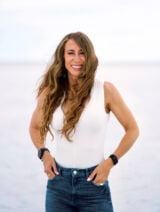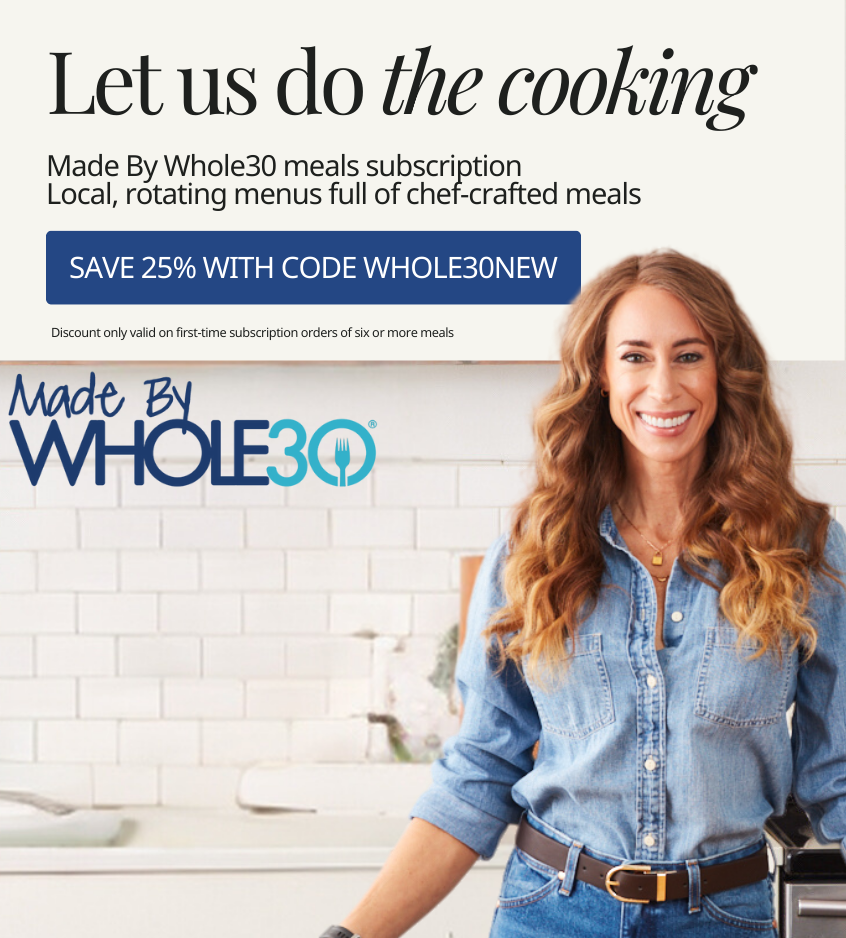In the early days of Whole30, the first Whole30 testimonials I shared on both my CrossFit training blog (where the Whole30 was born) and our website included full-body before-and-after photos. My audience was mostly fit, athletic CrossFit devotees who chose to submit new workout PRs, weight and fat lost, and aesthetic results in praise of the program. I published them, without realizing I was creating a dichotomy of culture within my own program.
“Focus on non-scale victories, don’t weigh yourself” the rules proclaimed, even from the very beginning. “I feel amazing, I have more energy, I’m sleeping better, I’m happier, and I PR’d my CrossFit Total,” our written testimonials said.
“Here’s Lauren, she looks visibly smaller,” our photos shouted. Or “Here’s Ted, you can now see a six-pack.” Or “Here’s Jessica, her clothes are super loose.”
I didn’t know the effect of this choice then. I assumed everyone thought about the program the way I did, from my place of unearned privilege, only a loose association with diet culture, and no history of disordered eating—that the real benefits of the Whole30 didn’t show up on the scale, and the NSVs were both the motivation and the goal. What I didn’t realize was the real story the photos were telling.
There’s a Before You, and they weren’t as praise-worthy or good as the After You. Smaller, leaner, or more muscular is your Whole30 goal, even if that’s not explicitly communicated. (Otherwise, why would all of the photos “selling” the program depict this same trend?) We TOLD people not to focus on their body weight, but our photos were solely focused on people’s bodies and how they looked.
It was a hypocrisy that I didn’t even realize was happening until we were called in to learn more about diet culture. And today, I want to share with you where we are now, and what we are doing to highlight Whole30’ers success stories without feeding into diet culture or misrepresenting the program.
Around 2017, we intentionally shifted away from that storytelling strategy and stopped posting before and after photos. Here are the explicit reasons why we made this switch, as food for thought in your own Whole30 journey:
- Before and after photos send the message that the benefits of the Whole30 are external and largely related to body shape and size when, in reality, most of what is amazing about your Whole30 results cannot be seen. Consider some of these invisible yet powerful NSVs: feeling happier, handling stress better, feeling at peace with food, listening to your body, experiencing less pain or fatigue, feeling part of a community, self-efficacy and the spillover effects it has in all areas of someone’s life.
- Before and after photos are meant to visually represent a positive change, with the suggestion that the after photo represents an outcome that is better than the before. While diet culture may say that certain bodies are better, healthier, more worthy, or more valuable than others because of the way they look, we know this isn’t true. Whether or not someone becomes smaller, leaner, or more in line with what society deems attractive during their Whole30 journey has no bearing on the success or impact of that journey.
- Before and after photos send an instantaneous message that the Whole30 is a weight loss diet, which it isn’t. The Whole30 is a food elimination and reintegration practice that offers the opportunity to reset your health, habits, and relationship with food. We focus on NSVs and ask our community members to step away from the scale and focus on all of the ways that their life is changing through the Whole30 outside of the number on the scale or the tape measure. You know this. We know this. But someone seeing a before-and-after photo on our website or Instagram feed gets an immediate (and highly inaccurate) picture of what Whole30 is and is not.
- Posting before-and-after photos, even with careful explanations of all of the above, still encourages you to focus on weight loss as a major goal for your program, which sets you up to fail. You will focus on that “after” body at the expense of your non-scale victories, will subconsciously adjust the program (cutting fat, calories, meals) to attain your goals, and use those photos as role models, no matter how much “NSV” language we provide around them.
We recognize that many people come to our community because they’re interested in changing their body composition or weight, and we honor that. And also, we are not in the business of making bodies smaller or leaner. We facilitate an experience where Whole30’ers can take a well-deserved break from their preoccupation with counting calories, weighing themselves, and feeling stuck in the mirror, and use that space, time, and energy to reclaim their relationship with food, health, and habits.
I will always honor and respect the right of a Whole30’er who wants to lose weight to do with their body as they choose. But I must make it clear that Whole30 will focus on telling the story of how your sleep, energy, self-confidence, stress management, mood, cravings, pain or fatigue, capacity to manage chronic illness, and your self-talk have improved as the result of your efforts. And that clarity of focus and vision will carry through to the images that we feature on our website and social media.
Since we DO love and celebrate the diverse bodies of our Whole30 community, how can we tell that story without sending mixed signals? Here are other ways that Whole30 HQ is choosing to celebrate community members who are feeling more comfortable and confident in their bodies after the Whole30:
- We DO share photos of people now living their life with joy! We skip the entire before and after comparison, because seeing someone who feels happy and empowered in their body is compelling all on its own.
- We DO use images and language to share about the importance of NSVs. Our storytelling makes it clear that the way our community members feel after their Whole30 is always going to be more valuable than the way they look.
- We DO talk about confidence, improved body image, and more self-love and acceptance as parts of healthy self-esteem, which is an inside job.
- When commenters publicly share their weight loss, we DO keep our HQ response focused on how proud we are of their hard work and dedication and ask follow-up questions about how they feel.
- We ARE deliberate and relentless in our messaging that the Whole30 is not a weight loss diet. We actively highlight dozens of reasons why the Whole30 is life-changing and empowering, in a way that has nothing to do with body size or shape.
I hope you find this story of our evolution helpful in your own Whole30 journey. If you’re looking for even more ways to understand what the Whole30 is and is not, the Whole30 Weight Loss Hub is a great resource for education about Whole30’s stance on weight loss and why weight loss is not one of our goals. You can also lean heavily on the Whole30 Mindset Checklist to make sure you are in the right headspace before your program even begins.
Best in health,
Melissa
You Might Also Like…
Got a question for Melissa? Submit it Here.
Remember, we aren’t answering questions about the Whole30 rules via this column (use the forum!), nor are we able to offer you specific advice about your medical issue, health condition, or body composition.















